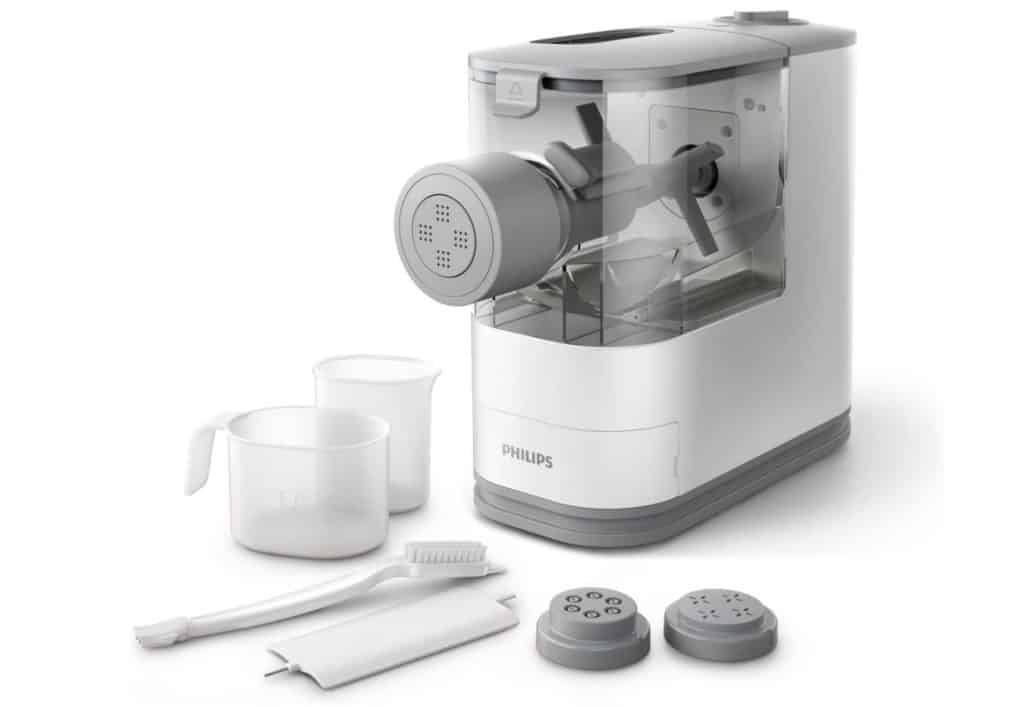As an occasional homemade pasta maker, I’m generally OK with a manual pasta maker but I know I’d make it more if I had a motor doing the work for me. So what’s the electric pasta maker to get in 2021?
What Is An Electric Pasta Maker?
For our purposes an electric pasta maker is any device that makes pasta using a motor. So we will be included dedicated pasta makers and attachments. Yes, this is not up to the exactly definitions HelpAtMyHome normally adheres to, but a pasta maker is a niche enough device and is seldom enough used that an attachment is often the more practical choice.
These pasta makers are typically used to make Italian pastas, like spaghetti, but they’ll have no problem making ramen, soba, or udon.
Dedicated Pasta Makers
A favorite of wedding registries and the Christmas season, a dedicated electric pasta maker is a wonderful device that does nothing but make homemade pasta (and, to be fair, noodles). These aren’t the most practical of devices because they are large, expensive, and have a single function, but they are quite good at that one function.

Philips Pasta Maker Plus
The crowd favorite in the world of electric pasta makers is the Philips Kitchen Pasta Maker Plus (model HR2357/05). This is Philips large-size electric pasta maker and it is capable of making about 3 pounds of pasta an hour or a single-size serving of 1/4 pound in 5 minutes.
It’s a large device (12.4 x 13.5 x 8.5 inches) and at 15 pounds it’s not light either. This maker has a 21 ounce capacity so you can make pasta for about 6 people in a single filling.
This maker includes discs for making fettuccine, penne, lasagna, and spaghetti, but more discs are available if you buy the accessory kit or buy the upgrade version with the kit included.

Philips Compact Pasta and Noodle Maker
The smaller version of the Philips pasta maker is the Philips Compact Pasta and Noodle Maker (HR2370/05). This model is a good deal smaller and a $100 cheaper, but it’s designed smaller meals. The output of this machine is just 3 servings per cycle so you won’t be making massive amounts of pasta with this one.
It includes 3 interchangeable discs which can create different pasta shapes (spaghetti, penne and fettuccini). The maker is about 10 pounds and 13 x 15.5 x 12 inches, and has a maximum capacity of 14 ounces (3.5 servings).
This smaller version can make 3 pasta servings in about 20 minutes, making it a bit small for families but fine if you are planning ahead. You can just make the pasta and put it on a pasta drying rack while dinner approaches.
Pasta Maker Attachments
Of course the more popular way to go is with an attachment for your kitchen mixer. Many people have a Kitchen-Aid or similar mixer which has a powerful motor and accepts attachments.

The metal KitchenAid KSMPRA Pasta Roller set will cost you about $200, which is by no means cheap, but it’ll be more space efficient than a dedicated pasta maker and it’ll be a much simpler device that is not in anyway prone to breaking. This is a more traditional approach which resembles a manual pasta maker.

KitchenAid also sells the KSMPEXTA Gourmet Pasta Press, which is more like the electric pasta makers above, as opposed to a do-it-yourself pasta machine. With this design you still will be able to extrude spaghetti, bucatini, fusilli, and other popular shapes, but you will have no ability to customize thickness. With this maker you can produce noodles in addition to traditional pastas and macaroni.
These pasta makers work well and they are easy to store. The KitchenAid has more than enough power to produce nice pasta, even without an egg inside to add moisture. These makers require more work than a dedicated electric pasta maker, but if you already have the KitchenAid machine, you can save money and get a setup that will last basically forever.
If you are OK buying an off-brand name you can save about $100 on your pasta maker attachment, but I’ve never used a non-KitchenAid model and can’t speak to their quality or materials.

